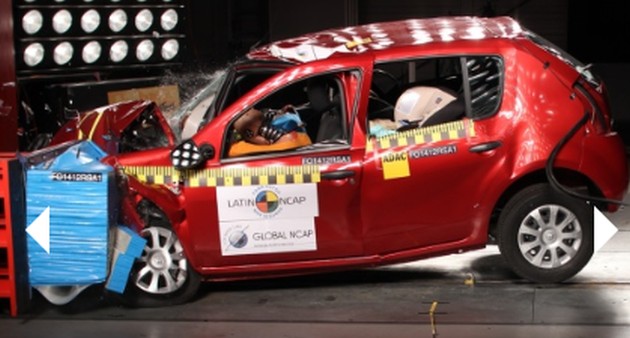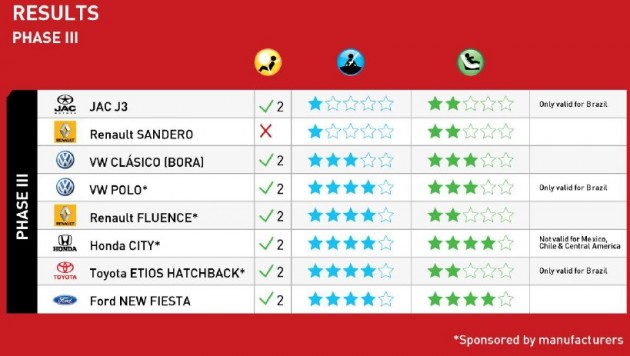Ah, it seems that there are plenty of places where safety levels of cars leave much to be desired, and crash testing is showing them up. Over in Latin America, the latest results released by the Latin NCAP reveal that some popular cars sold in the region have safety levels twenty years below global standards.
The recently concluded Phase III testing revealed two out of the eight cars tested falling well short – the Renault Sandero and the JAC J3 both gained a single star, the Sandero achieving the rating due to the model’s unstable body shell performance and lack of airbags.
Latin NCAP reports that this is a disappointing result from Renault, stating that the company is clearly capable of doing much better, as shown by the other Renault model tested, the four-star Fluence.
Meanwhile, the test saw the JAC 3 also ending up with one star, despite having two airbags. Latin NCAP said that this shows clearly that airbags cannot compensate for poor structural crashworthiness, and that body shell strength in protecting occupants in a crash is of vital importance.
Nonetheless, the results in phase three shows a significant increase in the number of four-star cars, with five models achieving the rating (Ford New Fiesta KD, Honda City, Renault Fluence, Toyota Etios hatchback and the VW Polo hatchback).
The remaining model tested, the Volkswagen Clasico/Bora, scored just three stars, held back by its poor structural integrity. With phase three completed, Latin NCAP has now tested 26 models (full results here), including most of the region’s best selling cars.
Closer to home, the first steps in the ASEAN New Car Assessment Programme (ASEAN NCAP) are underway – a series of frontal offset crash tests at 64 km/h (consistent with the ANCAP test protocol) are due to be carried out under Phase I testing.
Honda Malaysia recently provided a new Honda City for the Malaysian Institute of Road Safety Research (MIROS) to run a crash test at the purpose-built NCAP crash lab in Malacca. The first crash test recorded a speed of 63.6 km/h, and another City is set to undergo an official ASEAN NCAP crash test in December. The Ford Fiesta, Hyundai i10, Nissan March, Perodua MyVi, Proton Saga and Toyota Vios are also set to be tested in Phase I.
Looking to sell your car? Sell it with Carro.











wow… ford fiesta!!!!
Omg Ranault is worst !
No. It’s the Dacia Sandero as James May always call!
the pics show low standard of safety level, in this case (for offset front collision into a deformable barrier), the front doors were buckled to an extent it may not open normally (jammed) and will require assistance from fire brigade.
rescuers may take longer to provide first aid, driver may die for example losing too much blood. worst case scenario will be fire. the driver could be burnt alive.
same goes to the rear door.
but the same cannot be said on other Renault standard models which achieved 5 star ratings in Euro NCAP. crumple zones absorbed collision impact properly, allowing all the doors still can be opened easily.
for national cars, all protons until Waja (at least) suffer similar symptoms like Dacia Sandero.
but Gen2, Persona, Saga BLM and Exora passed this test with flying colours.
I remember back than someone was saying that the City won’t get good marks bcuz only hav 2 airbags where Ford hav 6. well he still may be true since we do not know what are the specs of the cars in latin america
ASEAN NCAP crash test in December. The Ford Fiesta, Hyundai i10, Nissan March, Perodua MyVi, Proton Saga and Toyota Vios are also set to be tested in Phase I.
Interesting. ^^
Not surprising, but indeed very disheartening. Mind you, this is a Renault car only in badge. The Sandero is a Dacia under the hood. But no airbags ? That’s unacceptable. Even the most basic of cars MUST come with at least 2 airbags today. All of the new Proton and Perodua cars come with 2 standard, 4 in the case of the Preve !
it must be damn expensive to replace the dummies.
LatinNCAP only test Offset Deformable Barrier (ODB) test. So a high rated car LatinNCAP car must not necessarily be good in EuroNCAP, especially since other critical tests are not done…
not sure how many star that end up with P1 and P2?
Ford Fiesta, Hyundai i10, Nissan March, Perodua MyVi, Proton Saga and Toyota Vios are also set to be tested in Phase I.
I’m actually excited to see the results for these cars. Especially the almighty Vios which people claim that its a toyota and its safe :) Myvi and Saga too as both are the best selling sedan and hatchbacks in Malaysia
Renault Sandero=tin milo construction?
Preve Euro NCAP got how many stars?
Preve in Australian ANCAP got 5 stars
Is it something like the history, where the export model got a better spec? Aussie get a better spec than M’sian?
It’s basically the same structure with Malaysia’s Preve… only different is they get 6 airbag whilst Malaysia 4… But i think the 6 airbag version will be available in malaysia during Preve SE / Facelift or the hatchback…
Ohh ! My car model will be tested. Hope it will score good marks, else it’s annyeong to it !
So what happens if P1 or P2 or even the popular Jepun makes fail the NCAP tests here ? Even if get 1 or 2 star, it shows that it ain’t that safe right ?
not to sidetrack the car brand bashing going on here, but does anyone here think that frontal crash testing at 64km/h is well……too slow???
when you consider that *most* of the sensationalized car crashes involve high speed (and usually an idiot behind the wheels, but i’m sure the dummies in the crash test would do their part) and they’re the ones usually causing injuries and death…..
I know that the test centre in melaka is just following NCAP rules but, isn’t the speed tested just too low?
Come on, a reasonable person would expect crash testing at 80km/h which is more likely the realistic scenario….. and thats the kind of info that would be really useful in determining how safe the car is…. (and pls, there is a HUGE difference between a crash at 64km/h and a crash at 80 or more km/h…. )
most accidents happen approximately within 64kmh speed if you take braking into account. however, it is also understandable that the car makers are making car for normal usage, not a tank and not a race car. here’s what i found;
Germany’s ADAC testing body wanted to find out what happens if the speed is raised just 10mph (16km/h) to 80km/h (50mph), and did so by testing the Renault Laguna sedan, a top performer in the standard tests. The results are surprising.
Raising the speed by just 10mph (16km/h) resulted in nearly 50% more energy to be dissipated by the car’s crumple zones, effectively exceeding their capacity. The increased energy resulted in a significant increase in risk of injury to all occupants, especially the driver, reports Autobild. The testing showed that the driver’s chest impacted the steering wheel despite the use of seatbelt and airbags due to the added speed, while the crumpling body of the car pushed the dashboard into the driver’s knees, risking injury there as well.
wow, impressively answered, guess i learned something here today…..
really good answer…
good for you, besides no vehicle will be safe enough to protect its occupant at a rather high speed – there is no point doing so.
already modern cars are suffering serious weight penalties by incorporating stronger body with better crumple absorption zones and safety equipment like airbags, abs with all its sensors, ECUs and wire harnesses.
Please do use your brains, before the vehicle crashes, The driver would normally slam the brakes damm hard, so yea it’s expected that the vehicle would slow down to that speed or even lower
Not when the driver’s eyes is looking somewhere else and not in front (e.g. SMS’ing).
There’s a reason as to why speed kills. If you’re already driving along at the designated speed limit, and is focused/alert on your driving, with that last second braking the speed will be close to the 64km/h.
In any case, if you still insist on a car that withstands higher speed accidents, most probably you’ll end up driving something very heavy, cumbersome at corners, slow and non economical…
Euro Ncap and Bolehland Ncap different standard?
Contis got junk cars too..
Japan’s version of Toyota VIOS, named as Toyota Belta (1000 cc, though) scored maximum 6 stars in JNCAP test for driver’s seat and passenger’s seat, respectively. The test consists of 3 types; Full-wrap frontal collision test, Offset frontal collision test and Side collision test. The test was conducted for the lowest spec which is known as Belta X.
The safety specs (passive safety) for Belta X is almost the same with ours VIOS Type J, such as:
Double airbags
Front seatbelt: 3-point ERL with Pre-tensioner and force limiter
Rear seatbelt: 3-point ERL
GOA body.
http://www.nasva.go.jp/mamoru/en/car_detail/58
Yaris, a hatchback version of Vios scored 5 stars in Euro NCAP. however, it has 7 airbags in Europe vs only 2 in Malaysian Vios.
number of airbags has little effect on total NCAP ratings, the impact is more towards passenger protection.
how a car absorbs a collision impact and divert the energy away from the passenger cabin is how euro ncap tests are conducted.
of course, number of airbags will make the difference between 4 stars and 5 stars but all the 4 stars gained mainly from the body structural strength. not ABS nor EBD, neither airbags.
I was always wondering what did they do with the crashed cars? Do they recycle materials and parts?